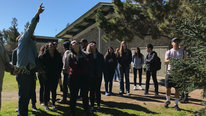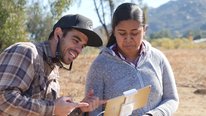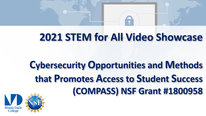
SHARON GUSKY
Northwestern Connecticut Community College
Engaging Students from Classrooms and Camps to College and Technical Careers
NSF Awards: 1801062
2021 (see original presentation & discussion)
Grades 9-12, Undergraduate
During the pandemic when we could not work in our labs, we adopted a bioinformatics project and taught high school students how to use a variety of bioinformatics tools to annotate a gene. The project was an extension of the SEAPHAGES project sponsor by HHMI. College students worked high school students to identified conserved repeats and promotor regions of the bacteriophage GEMG. This project introduced the high school to bioinformatics and biotechnical careers and gave the college students an opportunity to continue to develop their technical skills.
Science, Mentoring, Workforce Development
Torrington HS, NW CT Comm Coll
Advanced Technological Education (ATE)
Related Content for Using Bioinformatics to Introduce Students to Biotech Career
-
 2019IN LSAMP: Faculty Mentors Prepare Tomorrow's STEM Workforce
2019IN LSAMP: Faculty Mentors Prepare Tomorrow's STEM Workforce
Michelle Quirke
-
 2021Biotechnology Associates to Masters (A2M) Degree Program
2021Biotechnology Associates to Masters (A2M) Degree Program
Elizabeth Zulick
-
 2021STEM-CUREs Increase student access to research
2021STEM-CUREs Increase student access to research
Nichole Spencer
-
 2021Basic Skills in U.S. Subbaccalaureate STEM Programs
2021Basic Skills in U.S. Subbaccalaureate STEM Programs
Wonmai "Maia" Punksungka
-
 2021Enhancing (and Broadening) Engineering Talent in Tennessee
2021Enhancing (and Broadening) Engineering Talent in Tennessee
Megan Davis
-
 2021VolsTeach for Appalachia: Becoming a STEM Teacher
2021VolsTeach for Appalachia: Becoming a STEM Teacher
Nicholas Kim
-
 2019STEM research driven by students’ own funds of knowledge
2019STEM research driven by students’ own funds of knowledge
Laleh Cote
-
 2018STEM Artist Learning By Doing
2018STEM Artist Learning By Doing
Paul Slater
This video has had approximately 212 visits by 166 visitors from 110 unique locations. It has been played 83 times as of 05/2023.
Map reflects activity with this presentation from the 2021 STEM For All Video Showcase website, as well as the STEM For All Multiplex website. 
Based on periodically updated Google Analytics data. This is intended to show usage trends but may not capture all activity from every visitor.
Playlist: ATE Videos Playlist
Videos made by projects funded by the NSF ATE program from the 2021 and 2020 STEM for All Video Showcases.
-
 2021Guitars, Rocketry, Robotics
2021Guitars, Rocketry, Robotics
Chelsea Carnes
-
 2017STEM-Inc
2017STEM-Inc
Jidong Huang
-
 2021Using Bioinformatics to Introduce Students to Biotech Career
2021Using Bioinformatics to Introduce Students to Biotech Career
Sharon Gusky
-
 2021MATE Competition: Students Engineering Real-World Solutions
2021MATE Competition: Students Engineering Real-World Solutions
Jill Zande
-
 2021VR: Sustaining Social Interaction STEM Engagement and Access
2021VR: Sustaining Social Interaction STEM Engagement and Access
Jonathan Beck
-
 2021Rapid Response Additive Manufacturing Initiative (RRAMI)
2021Rapid Response Additive Manufacturing Initiative (RRAMI)
Eric Wooldridge
-
 2020Preparing Technicians for the Future of Work
2020Preparing Technicians for the Future of Work
Ann-Claire Anderson
-
 2020Guitars, Rocketry, and Robotics ATE
2020Guitars, Rocketry, and Robotics ATE
Chelsea Carnes
-
 2020From Classrooms and Camps to College and Technical Careers
2020From Classrooms and Camps to College and Technical Careers
Sharon Gusky
-
 2020Promoting Interest in Drone Applications and Careers
2020Promoting Interest in Drone Applications and Careers
Wing Cheung
-
 2020Incorporating Geospatial Technologies into the Classroom.
2020Incorporating Geospatial Technologies into the Classroom.
Devon Russell
-
 2020Scaling Up the Automated Manufacturing Technician Pipeline
2020Scaling Up the Automated Manufacturing Technician Pipeline
Mason Lefler
-
 2020The Future Workforce Begins with a Spark
2020The Future Workforce Begins with a Spark
Jonathan Beck
-
 2020Controls Tech Barbie and her Smart Barbie Grand Hotel
2020Controls Tech Barbie and her Smart Barbie Grand Hotel
Deb Hall
-
 2021Increasing Opportunities for Underrepresented Minorities
2021Increasing Opportunities for Underrepresented Minorities
Diego Tibaquira
-
 2020Merry Mobile Robot Platform
2020Merry Mobile Robot Platform
Mahmood Lahroodi
-
 2020AMP-IT-UP: Inspiring middle school teachers in STEM
2020AMP-IT-UP: Inspiring middle school teachers in STEM
Meltem Alemdar
show more
Discussion from the 2021 STEM For All Video Showcase (18 posts)
Patricia Marsteller
Professor of Practice Emeritus
Thanks for this adaptation of SeaPhages. I would like to share with members of my group who are working on Scientist spotlights and data.
I would love to hear more about how you are evaluating impact on students to this kind of work and what toools are available to make sure that students have access to appropriate internet resources?
Sharon Gusky
Professor
For impact, we have students complete pre and post surveys based on Grinell's Survey of Undergraduate Research Experiences. We are also evaluating the impact on the high school students by following their high school science course choices and college major choices. The high school students all had internet access and the college students helped them select the approriate internet resources to use. We only used resources that were freely available and did not need downloading.
Sharon Gusky
Professor
Welcome to my video on Using Bioinformatics to Introduce Students to Biotech Careers. This project gave us the opportunitiy to work with high school students remotely and provide them with the opportunity to participate in authenitic research remotely. The pairing of community college students as the lead researchers and mentors with high school students provided opportunities for both to developed their scientific reasoning skills and increase their knowledge. Students enjoyed the project and the interactions during the pandemic helped keep students connected.
Please let me know if you have any questions about our project.
Michael Moore
I love this creative way of helping students feel connected! So important over this last year and cannot be emphasized enough! Great work Sharon!
Sharon Gusky
Professor
Thanks, Michael.
Anya Goodman
Sharon, thank you for sharing your project - watching your presentation made me realize that connecting undergrads as mentors for high school students is a terrific way to develop leadership and project ownership! I am part of the Genomics Education Partnership (GEP) where we are also using genomics to bring research to undergraduate students, but working with eukaryotic genes (if your students experienced with phages want to move into eukaryotic genes - we got projects for them and we are actively recruiting CC faculty/student teams). Over the pandemic/transition to virtual research, we/GEP also came to realize the value of peer-mentoring by hiring experienced students as virtual TAs to lead/teach new students (so CC students may be acting as virtual TAs for undergrads nationwide). After watching your video, I want try to expand our local connections to high schools! I wonder if the college student's mentoring HS student research team can also help increase the pool of undergrads considering STEM teaching careers! Did any of your students express an interest in teaching HS science after their experience?
Sharon Gusky
Professor
Anya, your GEP project sounds interesting and would like to give my students the opportunity to get involved with eukaryotic genes. Yes, I found that the college students became interested in teaching after working with the high school students. They enjoyed sharing their knowledge with them and mentoring them.
Alexa Sawa
GEP and SeaPhages go well together if you have the time. We have at least one GEP member who uses both at her CC. Like everyone else I think the pairing of your students with high school students was a great idea.
Sharon Gusky
Professor
Thank you, Alexa. I think GEP would work well with my students. I am hoping that there is a fall or alternative training session. When I looked at the summer schedule, I could not participate due to other committments.
Patricia Marsteller
Professor of Practice Emeritus
So cool. Love the ideas of connecting undergrads and high school students...there are so many advantages for UG mentors .
One of the things that is imprtant is to prepare them to mentor others especially if the schools are more diverse than the UG. Have you developed ways to prepare the UGs for this? I have had some projects that used resources from Entering Mentoring and Entering Research to help.
Sharon Gusky
Professor
While there are differences in diversity between the community college popuation and the high schools (and community), our college students come from the local high schools and live in the community so we have not found the differences in diversity to be an issue. We do provide basic mentoring training but I will look into the resources that you mention. Thank you, Pat.
Jay Labov
Senior Advisor for Education and Communication (Retired)
I echo everyone else's comments in congratulating you on this novel and important approach of having undergraduates work with high school students. There are clear benefits for both groups of students. I'm wondering whether and how you might involve high school teachers in this kind of work? For example, I could envision a three-way partnership involving an undergraduate from your college, a high school student, and that high school student's science teacher. Another possible arrangement is something similar to NSF's Research Experiences for Teachers initiative (Research Experiences for Teachers Sites in Biological Sciences (BIORETS) (nsf21584) | NSF - National Science Foundation) where CC faculty, their undergraduate students, and teachers (and perhaps the teacher's students?) might work together on an authentic research project such as the one described in the video. Given that this project was done primarily online, it could be particularly amenable to teachers who may be looking for a research experience but who may not be able to devote time in an in-person experience.
Thanks again for posting!
Sharon Gusky
Professor
Thank you, Jay. I was not aware of the BIORETS program and you are right it is a good fit. The high school teachers have attended some sessions to see what their students are doing but having them participate in the research as well is a great idea.
Patricia Marsteller
Professor of Practice Emeritus
Hi Sharon
I had some grants for Research Experiences for Teachers in the past. I think these programs are exceptionally valuable especially i one pairs UG in the same experience!
Go for it!
Sharon Gusky
Professor
Thanks for the encouragement. I will give it a shot.
Judith Dilts
Retired Associate Dean, College of Science and Mathematics
Great way to connect high school and college students with a real research project. What kind of training prepared the college students for working with and mentoring high school students? Also, do you plan on continuing the project virtually even when in person learning is allowed?
Thanks! Judy
Sharon Gusky
Professor
Thank you, Judy. The training has been fairly informal. They meet with one of the STEM faculty to cover mentoring basics and then the entire group meets with me weekly. Yes, we plan to continue virtually but we are adding a wetlab discovery option for an in-person experience. The virtual works really well for the bioinformatics research and it allows students without transportation to participate.
Judith Dilts
Jay Labov
Senior Advisor for Education and Communication (Retired)
Sorry for the delay in getting back into this discussion. Engaging teachers to become part of policy- and decision-making in education is, to me, a critical component of teacher leadership ranging from a teacher's classroom to the entire school, school district, and for some, at the state and national levels. As a point of information, TERC, the organizer of this STEM For all Video Showcase, also has another project supported by the NSF called the STEM Teacher Leadership Network. In the 18 months of its existence, it has amassed an impressive array of monthly webinars, blogs, and other resources related to teacher leadership. It's worth checking out if you are a K-12 STEM teacher at any stage of your career or someone who works with or learn from STEM teachers. I'm proud to serve on the Network's advisory board.
Sharon Gusky
Further posting is closed as the event has ended.